| Author |
Message |
|
Niels Just Rasmussen
|
 Posted: Wed 16 Dec, 2015 8:28 am Post subject: Posted: Wed 16 Dec, 2015 8:28 am Post subject: |
 |
|
| Mark Lewis wrote: | After a bit of cross referencing, I think all the long-gripped swords in this display can be identified. For convenient future reference, from right to left:
D 13492, Tudeå - http://myArmoury.com/talk/viewtopic.php?p=298679#298679
D 1496 - Hoffmeyer, XXXVII.a. The cross appears to be loose, and slipped forward over the ricasso
D 11.695 (or 11695?) - Hoffmeyer, XXXVI.b
D 16140 - Hoffmeyer, XXXVII.b
D 8804, Soborg Lake - Hoffmeyer, XXXV.e
D 4850, Helsingør - Hoffmeyer, XXXV.d. Schmid, 6a
D 358 - Hoffmeyer, XXX.b
D 4446, Hinge Sø - Hoffmeyer, XXXVIII.a

|
I wonder whether the D 358 sword (the one right of the Hinge Sø sword) isn't one of the two "panzerstechers" found in Sperring Sø, very close to Sjørring Sø (the one on the right found in 1868).
Thread: http://myArmoury.com/talk/viewtopic.php?t=32523&highlight=
I made a mistake in that thread-title since the two "panzerstechers" are from Sperring Sø, and not the adjacent Sjørring Sø (where you found viking swords instead).
Pommel‚ length of fuller and overall shape seems to fit. Though on the picture above it perhaps looks like the D 358 has a Type T1 pommel (which would be extraordinary rare - seen also on the Ordrup Mose sword) whereas the Sperring panzerstecher has a Type T2.
| Mark Lewis wrote: | | Niels Just Rasmussen wrote: | Besides the D 1496 you have at least one other Danish sword with upturned cross-guard ends.
This is a sword found in 1977 in a grave near Øm Kloster and described in Nymark (1980). |
I quite like this type of cross, very graceful looking. There is another example supposedly in the Nationalmuseet shown in the Schmid article, but I don't see the inventory number given, and it doesn't seem to appear in Hoffmeyer. It appears to have very similar proportions to the Øm Kloster example, but just a bit larger in all dimensions.

|
So you found another one!  - the article does show a lot of swords from Nationalmuseet sadly without inventory numbers or find locations. - the article does show a lot of swords from Nationalmuseet sadly without inventory numbers or find locations.
I agree the cross-guard is graceful.
Is it a type a cross-guard you have example of in Germany or elsewhere?
The article also informs that is has a mark - two six-sided stars within rings one over the other!
Last edited by Niels Just Rasmussen on Wed 16 Dec, 2015 9:48 am; edited 1 time in total
|
|
  |
 |
|
Mark Lewis
|
 Posted: Wed 16 Dec, 2015 9:42 am Post subject: Posted: Wed 16 Dec, 2015 9:42 am Post subject: |
 |
|
| Niels Just Rasmussen wrote: |
I wonder whether the D 358 sword (the one right of the Hinge Sø sword) isn't one of the two "panzerstechers" found in Sperring Sø, very close to Sjørring Sø (the one on the right found in 1868).
Pommel‚ length of fuller and overall shape seems to fit. Though on the picture above it perhaps looks like the D 358 has a Type T1 pommel (which would be extraordinary rare - seen also on the Ordrup Mose sword) whereas the Sperring panzerstecher has a Type T2. |
Good eye! I'm sure you are correct. higher resolution photos in Koppeschaar's album confirm that the pommel is type T2, and the sword is shown in Hoffmeyer grouped with the archetypes of the Sempach family of XVII.T2's.
|
|
   |
 |
|
Niels Just Rasmussen
|
 Posted: Wed 16 Dec, 2015 10:30 am Post subject: Posted: Wed 16 Dec, 2015 10:30 am Post subject: |
 |
|
| Mark Lewis wrote: | | Niels Just Rasmussen wrote: |
I wonder whether the D 358 sword (the one right of the Hinge Sø sword) isn't one of the two "panzerstechers" found in Sperring Sø, very close to Sjørring Sø (the one on the right found in 1868).
Pommel‚ length of fuller and overall shape seems to fit. Though on the picture above it perhaps looks like the D 358 has a Type T1 pommel (which would be extraordinary rare - seen also on the Ordrup Mose sword) whereas the Sperring panzerstecher has a Type T2. |
Good eye! I'm sure you are correct. higher resolution photos in Koppeschaar's album confirm that the pommel is type T2, and the sword is shown in Hoffmeyer grouped with the archetypes of the Sempach family of XVII.T2's. |
Great to have that settled.
Also want to point out the special case about D 16140.
It so far the only Danish type XVIIIe (with long narrowed ricasso) with a totally straight (and short) non-curving cross-guard.
Haven't found any info on it; maybe Bruhn-Hoffmeyer has some info elsewhere in her book about it?
|
|
  |
 |
|
Mark Lewis
|
|
   |
 |
Daniel Wallace

Location: Pennsylvania USA Joined: 07 Aug 2011
Posts: 580
|
 Posted: Thu 17 Dec, 2015 9:11 am Post subject: Posted: Thu 17 Dec, 2015 9:11 am Post subject: |
 |
|
personally, just reading through this I'm getting interested in D 11695. I did some fiddling last night through an image program, provided that the plate in the initial post shows all the swords in correct proportion to each other, I blew up the sword next to it that Niels provided information on. once blown up to size, I think I can pull a rough estimate of that sword's stats. D 11695 is broken, but - the tips of these swords seems relatively easy to find if you follow the profile of the blade.
I've only got tinkering time to mess with it - so I don't think I'll arrive at any estimates soon if it interests anyone. I think this would come to a decent conclusion of measurements, I did the same process for a two hander in the Wallace collection aa473 which I built a model from, although I haven't had the time to put together my findings of the sword for everyone yet, I think that I got very close to the proper proportions of the sword.
these two handers are pretty unique, at least the ones with the slim ricasso. I would theorize much like the two handers of the low countries, these extended ricassos would be to help keep the base of the blade robust, but a better idea is that there is simply no need for the blade to be present that low to the guard, and your attempting to conserve weight so why not just eliminate the bevels all together.
great findings here - been waiting to see a post like this for a while.
|
|
  |
 |
|
Mark Lewis
|
 Posted: Thu 17 Dec, 2015 7:04 pm Post subject: Posted: Thu 17 Dec, 2015 7:04 pm Post subject: |
 |
|
| Daniel Wallace wrote: | personally, just reading through this I'm getting interested in D 11695. I did some fiddling last night through an image program, provided that the plate in the initial post shows all the swords in correct proportion to each other, I blew up the sword next to it that Niels provided information on. once blown up to size, I think I can pull a rough estimate of that sword's stats. D 11695 is broken, but - the tips of these swords seems relatively easy to find if you follow the profile of the blade.
great findings here - been waiting to see a post like this for a while. |
Hi Daniel, glad it's of interest to you! I really don't know whether Hoffmeyer's photos are accurately scaled, though the scale in this particular plate doesn't seem obviously off in any way... I presume there are measurements in the accompanying text, but I don't have that at hand unfortunately.
|
|
   |
 |
|
Niels Just Rasmussen
|
 Posted: Fri 18 Dec, 2015 7:26 am Post subject: Posted: Fri 18 Dec, 2015 7:26 am Post subject: |
 |
|
| Mark Lewis wrote: | | I have some other examples... |
Great findings Mark.
So it's a diverse spread of this cross-guard type:
Denmark/Norway as a twin kingdom has (3+2) 5 and Sweden/Finland has 2.
So it is no longer feasible to say that the guard-type is particular "Polish".
Also it's worth to remember that place of most popularity doesn't have to be the same as place of origin.
The second Norwegian sword is a really impressive 2-hander with a 47,5 cm long grip!
Total length 137 cm, but the tip is missing so around 140 cm seems reasonable.
| Daniel Wallace wrote: | personally, just reading through this I'm getting interested in D 11695. I did some fiddling last night through an image program, provided that the plate in the initial post shows all the swords in correct proportion to each other, I blew up the sword next to it that Niels provided information on. once blown up to size, I think I can pull a rough estimate of that sword's stats. D 11695 is broken, but - the tips of these swords seems relatively easy to find if you follow the profile of the blade.
I've only got tinkering time to mess with it - so I don't think I'll arrive at any estimates soon if it interests anyone. I think this would come to a decent conclusion of measurements, I did the same process for a two hander in the Wallace collection aa473 which I built a model from, although I haven't had the time to put together my findings of the sword for everyone yet, I think that I got very close to the proper proportions of the sword.
these two handers are pretty unique, at least the ones with the slim ricasso. I would theorize much like the two handers of the low countries, these extended ricassos would be to help keep the base of the blade robust, but a better idea is that there is simply no need for the blade to be present that low to the guard, and your attempting to conserve weight so why not just eliminate the bevels all together.
great findings here - been waiting to see a post like this for a while. |
Thanks for your input Daniel.
Will be interested to hear your estimates, when you arrive at them!
As to the extended narrow ricasso I would speculate that they are not just a random fashion look - as these swords seem to be real war swords and not "show swords" - but has a definite function.
So whether the ricasso is for half-sword-techniques for gripping the blade, whether it is a weight reduction OR a blade balance & blade-vibration choice is hard to say without extensive minute research of several of these swords.
|
|
  |
 |
|
Niels Just Rasmussen
|
 Posted: Fri 18 Dec, 2015 8:05 am Post subject: Posted: Fri 18 Dec, 2015 8:05 am Post subject: |
 |
|
| Mark Lewis wrote: |
Thanks for sharing! Several others in that display can be recognized in Hoffmeyer's plates I think. Speaking of which, here is plate 32 which shows two more long-gripped swords in Copenhagen:
 |
Found a sword from the E.A. Christensen collection sold at Bonhams in 2012, which looks like the the Swords a) + b) on the Bruhn-Hoffmeyer Plate in regard to the cross-guard, but with a different pommel.
Lot 74 classified as a type XVIII.
Total length: 101,4 cm.
Blade length: 74,7 cm.
Middle long grip with a "shortish" blade.
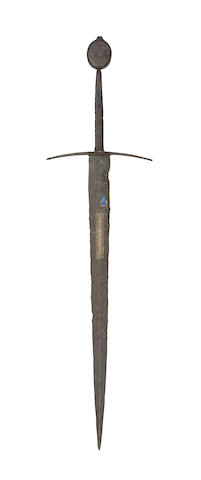
Source: http://www.bonhams.com/auctions/19796/lot/74/
|
|
  |
 |
|
Mark Lewis
|
 Posted: Fri 18 Dec, 2015 4:05 pm Post subject: Posted: Fri 18 Dec, 2015 4:05 pm Post subject: |
 |
|
| Niels Just Rasmussen wrote: | So it's a diverse spread of this cross-guard type:
Denmark/Norway as a twin kingdom has (3+2) 5 and Sweden/Finland has 2.
So it is no longer feasible to say that the guard-type is particular "Polish".
|
Certainly it is not exclusively Polish, but the distribution does seem to have a strong bias towards the Eastern and Northern nations.
| Niels Just Rasmussen wrote: | Found a sword from the E.A. Christensen collection sold at Bonhams in 2012, which looks like the the Swords a) + b) on the Bruhn-Hoffmeyer Plate in regard to the cross-guard, but with a different pommel.
Lot 74 classified as a type XVIII.
Total length: 101,4 cm.
Blade length: 74,7 cm.
Middle long grip with a "shortish" blade.

Source: http://www.bonhams.com/auctions/19796/lot/74/ |
The hilt is not quite so long in comparison to the blade as it appears here... I've found the photography at Bonhams to be fairly poor; most swords appear badly foreshortened, distorting the overall proportions.
The purchaser of this sword (and another from the same sale) used to have photos online, but it seems the site is no longer active. Here is one I saved that shows the proportions a bit better.

A few other pictures may have survived on Pinterest: https://www.pinterest.com/pin/330733166363870656/
|
|
   |
 |
|
Niels Just Rasmussen
|
 Posted: Sat 19 Dec, 2015 4:47 am Post subject: Posted: Sat 19 Dec, 2015 4:47 am Post subject: |
 |
|
| Mark Lewis wrote: | The hilt is not quite so long in comparison to the blade as it appears here... I've found the photography at Bonhams to be fairly poor; most swords appear badly foreshortened, distorting the overall proportions.
The purchaser of this sword (and another from the same sale) used to have photos online, but it seems the site is no longer active. Here is one I saved that shows the proportions a bit better.

A few other pictures may have survived on Pinterest: https://www.pinterest.com/pin/330733166363870656/ |
True that is a much better picture! So it seems like it is a one-and-a-half sword more than a 2-hander with "shortish" blade.
 [/quote] [/quote]
Actually I had missed it at first: The a) sword on the Bruhn-Hoffmeyer Plate actually have slightly upturned cross-guard ends - it's quite faint, but certainly there. So that gives us 4 from Denmark with this type of cross-guard.
This type of sword - whether it has upturned ends on the cross-guard or not - is quite interesting in that they are often fairly blade-short, but with either one-and-a-half or 2-handed length grips.
|
|
  |
 |
Daniel Wallace

Location: Pennsylvania USA Joined: 07 Aug 2011
Posts: 580
|
 Posted: Sun 20 Dec, 2015 8:51 am Post subject: Posted: Sun 20 Dec, 2015 8:51 am Post subject: |
 |
|
I'll be attempting to blow up the few pics I have that were presented here in the post later today. and with the next few days off from work, I think I can get some rough figures to present.
I have to go back through the post, I've got a few opinions of the ricasso. I attempt to focus and give theory's of the use of two handers by the way their built, and a little by period writing's. right now I've only got ideas to throw out there that may be really off the wall ideas about the this style. something that is really getting my attention is the upturned quillons, very limited in comparison to the other two handers I've looked over.
I'm familiar with the Memorial, and Marozzo, is there any northern writings I may be able to look up that might help shed some light on the use of these swords? it may help as I put a model together as to why they were build in the way they are.
|
|
  |
 |
|
Niels Just Rasmussen
|
 Posted: Sun 20 Dec, 2015 9:37 am Post subject: Posted: Sun 20 Dec, 2015 9:37 am Post subject: |
 |
|
| Daniel Wallace wrote: | I'll be attempting to blow up the few pics I have that were presented here in the post later today. and with the next few days off from work, I think I can get some rough figures to present.
I have to go back through the post, I've got a few opinions of the ricasso. I attempt to focus and give theory's of the use of two handers by the way their built, and a little by period writing's. right now I've only got ideas to throw out there that may be really off the wall ideas about the this style. something that is really getting my attention is the upturned quillons, very limited in comparison to the other two handers I've looked over.
I'm familiar with the Memorial, and Marozzo, is there any northern writings I may be able to look up that might help shed some light on the use of these swords? it may help as I put a model together as to why they were build in the way they are. |
Since the type XVIIIe shows up mostly in Scandinavia (but also apparently a few in Italy), then you are limited to mentions in Italian sources, since we don't have any Scandinavian fighting manuals from the middle ages.
NB: Salvator Fabris made his great rapier works within the "Danish Sphere" (Danish Kingdom and Slesvig-Holsten) from 1601-1606, but then it's based on rapier on the fighting style he had taught in Padova and not any focus on Scandinavian style weapons.
Look forward to what you have to say about the ricasso!
|
|
  |
 |
|
Niels Just Rasmussen
|
 Posted: Sun 20 Dec, 2015 10:48 am Post subject: Posted: Sun 20 Dec, 2015 10:48 am Post subject: |
 |
|
I FINALLY found a church painting of what looks like a "Danish style two-hander". A bit unclear if it has a ricasso or not, but the looooooonng grip with the iron threads in bands is typical.
Sadly the painting is a bit damaged right around the cross-guard  . Does it have one straight quillon to the left of the image and what is that round thing? a pretzel?? . Does it have one straight quillon to the left of the image and what is that round thing? a pretzel??
The art style is late gothic - Dating: 1490-1510.
It is from Roskilde Domkirke (Roskilde Cathedral - where the XVIIIe sword of Christian I is also on display) and shows Paulus (Paul) holding a big sword.
 Attachment: 151.14 KB Attachment: 151.14 KB

Paulus with two-handed sword.
Roskilde Domkirke:
Source: http://natmus.dk/salg-og-ydelser/museumsfaglige-ydelser/kirker-og-kirkegaarde/kalkmalerier-i-danske-kirker/
Last edited by Niels Just Rasmussen on Mon 28 Dec, 2015 4:51 am; edited 1 time in total
|
|
  |
 |
|
Niels Just Rasmussen
|
 Posted: Sun 20 Dec, 2015 11:10 am Post subject: Posted: Sun 20 Dec, 2015 11:10 am Post subject: |
 |
|
Guess I'm in luck.
Weird looking cross-guard on this two-hander (angular break forwards) and without ricasso but with a square (rain-guard?) thingy instead. From Dråby Kirke on Sjælland (Zealand).
Angel with sword (not flaming) chasing Adam and Eve out of the Garden of Eden.
Art-style is Gothic (1375-1475).
Dating 1460-1480.
And also from Dråby Kirke Paulus with a two-hander (Paulus changes from generally holding one-handed swords to holding two handers from the Gothic Art style period).
Here the artist made at least one of the quillons less angular and more curving forwards. Still no ricasso on the sword.
 Attachment: 152.99 KB Attachment: 152.99 KB

Angel with two-hander.
Dråby Kirke.
Source: http://natmus.dk/salg-og-ydelser/museumsfaglige-ydelser/kirker-og-kirkegaarde/kalkmalerier-i-danske-kirker/
 Attachment: 109.91 KB Attachment: 109.91 KB
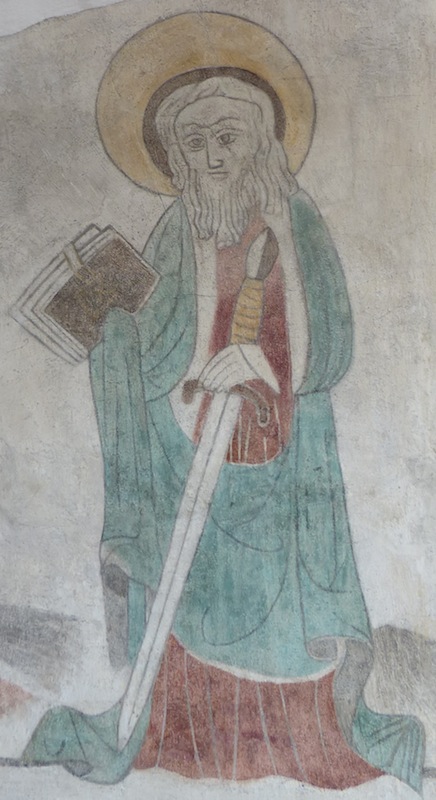
Paulus with two-hander.
Dråby Kirke.
Source: http://natmus.dk/salg-og-ydelser/museumsfaglige-ydelser/kirker-og-kirkegaarde/kalkmalerier-i-danske-kirker/
Last edited by Niels Just Rasmussen on Mon 28 Dec, 2015 4:49 am; edited 2 times in total
|
|
  |
 |
|
Niels Just Rasmussen
|
 Posted: Sun 20 Dec, 2015 11:48 am Post subject: Posted: Sun 20 Dec, 2015 11:48 am Post subject: |
 |
|
Man, the painter at Dråby Kirke must have had a fetish for two-handed swords. I have so far located 7 and some really weird ones!
This first is from the legend of Saint Laurentius where he is being roasted by Emperor Valerian I - who holds a two-hander with a super-weird grip and a style U pommel (key-shaped).
Another scene (Saint Laurentius brings the poor to the Emperor) shows Valerian I with another (the Emperor can change sword and clothes from scene to scene  ) quite long two-handed sword. ) quite long two-handed sword.
Then we have the execution of Pope Sixtus II with a weird cross-guard on that two-hander (performed by a guy with interesting fashion).
 Attachment: 130.79 KB Attachment: 130.79 KB
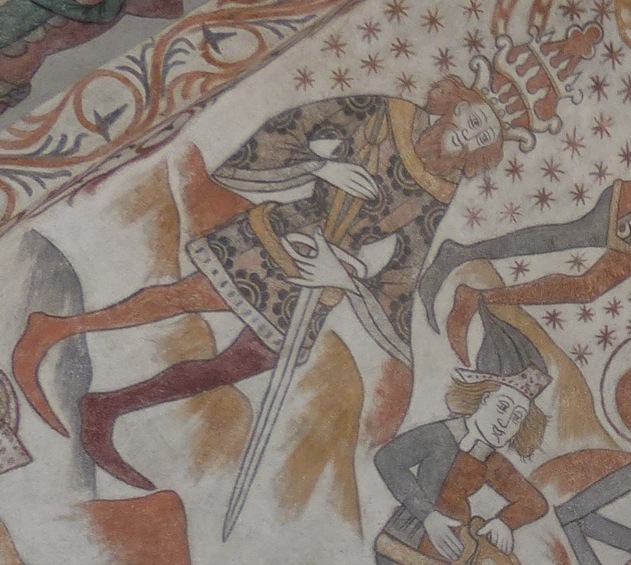
Emperor Valerian I.
Dråby Kirke.
Source: http://natmus.dk/salg-og-ydelser/museumsfaglige-ydelser/kirker-og-kirkegaarde/kalkmalerier-i-danske-kirker/
 Attachment: 169.28 KB Attachment: 169.28 KB
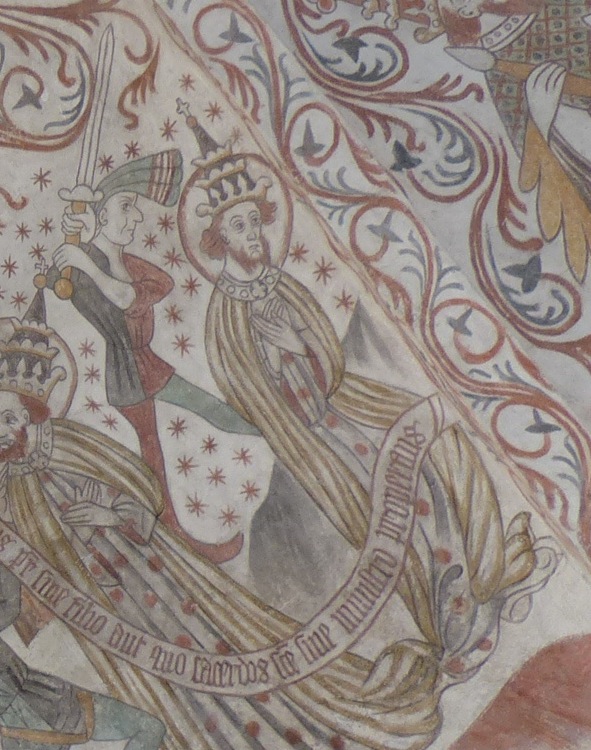
Execution of Pope Sixtus II.
Dråby Kirke.
Source: http://natmus.dk/salg-og-ydelser/museumsfaglige-ydelser/kirker-og-kirkegaarde/kalkmalerier-i-danske-kirker/
 Attachment: 143.6 KB Attachment: 143.6 KB

Saint Laurentius brings the poor to Emperor Valerian I.
Dråby Kirke.
Source: http://natmus.dk/salg-og-ydelser/museumsfaglige-ydelser/kirker-og-kirkegaarde/kalkmalerier-i-danske-kirker/
|
|
  |
 |
|
Niels Just Rasmussen
|
 Posted: Sun 20 Dec, 2015 12:25 pm Post subject: Posted: Sun 20 Dec, 2015 12:25 pm Post subject: |
 |
|
I'm on a roll.
Kongsted Kirke on Sjælland (Zealand) a gothic style (1375-1475) portrayal of Paulus with a hand-and-a-half sword with slightly upturned ends on the cross-guard 
Dating: 1425-1440.
PS: That is one nice looking sword!
 Attachment: 105.97 KB Attachment: 105.97 KB

Paulus with sword.
Kongsted Kirke.
Source: http://natmus.dk/salg-og-ydelser/museumsfaglige-ydelser/kirker-og-kirkegaarde/kalkmalerier-i-danske-kirker/
Last edited by Niels Just Rasmussen on Mon 28 Dec, 2015 4:47 am; edited 1 time in total
|
|
  |
 |
|
Mark Lewis
|
 Posted: Mon 21 Dec, 2015 5:55 pm Post subject: Posted: Mon 21 Dec, 2015 5:55 pm Post subject: |
 |
|
| Niels Just Rasmussen wrote: | I'm on a roll.
Kongsted Kirke on Sjælland (Zealand) a gothic style (1375-1475) portrayal of Paulus with a hand-and-a-half sword with slightly upturned ends on the cross-guard 
|
Great work Niels! Lots of material to compare with here... artwork involving St. Paul is always a great place to look for swords to compare with. There is plenty of disparity from the "typical" Scandinavian two-handers; how much is based on fact, and how much is artistic license??
It's good to see this example with the upturned ends of the cross, and your first example is great too:
| Niels Just Rasmussen wrote: | I FINALLY found a church painting of what looks like a "Danish style two-hander". A bit unclear if it has a ricasso or not, but the looooooonng grip with the iron threads in bands is typical.
Sadly the painting is a bit damaged right around the cross-guard  . Does it have one straight quillon to the left of the image and what is that round thing? a pretzel?? . Does it have one straight quillon to the left of the image and what is that round thing? a pretzel?? |
The distinctive style of banded grip is clearly shown... too bad the hilt is unclear, but it seems to me that there is only room for fairly short, straight quillons in the obscured area. I think it is also showing a very large, round rain-guard, just a bit more exaggerated than the ones you showed here:
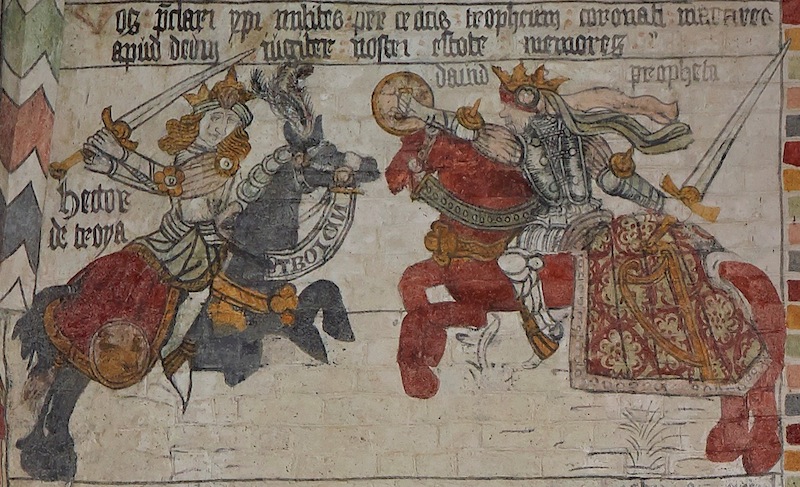
|
|
   |
 |
|
Niels Just Rasmussen
|
 Posted: Tue 22 Dec, 2015 4:37 am Post subject: Posted: Tue 22 Dec, 2015 4:37 am Post subject: |
 |
|
| Mark Lewis wrote: | | Niels Just Rasmussen wrote: | I'm on a roll.
Kongsted Kirke on Sjælland (Zealand) a gothic style (1375-1475) portrayal of Paulus with a hand-and-a-half sword with slightly upturned ends on the cross-guard 
|
Great work Niels! Lots of material to compare with here... artwork involving St. Paul is always a great place to look for swords to compare with. There is plenty of disparity from the "typical" Scandinavian two-handers; how much is based on fact, and how much is artistic license??
It's good to see this example with the upturned ends of the cross, and your first example is great too:
| Niels Just Rasmussen wrote: | I FINALLY found a church painting of what looks like a "Danish style two-hander". A bit unclear if it has a ricasso or not, but the looooooonng grip with the iron threads in bands is typical.
Sadly the painting is a bit damaged right around the cross-guard  . Does it have one straight quillon to the left of the image and what is that round thing? a pretzel?? . Does it have one straight quillon to the left of the image and what is that round thing? a pretzel?? |
The distinctive style of banded grip is clearly shown... too bad the hilt is unclear, but it seems to me that there is only room for fairly short, straight quillons in the obscured area. I think it is also showing a very large, round rain-guard, just a bit more exaggerated than the ones you showed here:
|
It's really hard to say when it comes to artistic license or not.
From my local area (Møn & Falster) you had in the middle ages a painter (or rather more likely workshop under a master) who painted in several churches. Tingsted kirke with the Herod scene killing babies with the s-curved swords is one of them. He is known as the Elmelunde Master: https://en.wikipedia.org/wiki/Elmelunde_Master
So he had a "set of scenes", which is copied from church to church - but the really interesting part is that the type of swords and also armour varies from scene to scene. So the master wasn't interested in just copy-pasting his work from church to church, but doing variations on a theme.
According to the search-function on the Nationalmuseet his workshop seems to be dated currently 1500-1520 and includes:
Elmelunde, Fanefjord and Keldby churces on Møn.
Bogø church on the small Island of Bogø.
Nørre Alslev, Kippinge, Aastrup and Tingsted churches on Falster.
Sometimes you see an attention to detail when it comes to hilt design (assume it must be correct then), whereas the sword blade itself often is more crudely depicted and can actually bend it various ways, probably an artistic license to fit with flowing inscription around the biblical figures.
I assume that sword blades had to fit the overall design: So sometimes the sword is just "cut" not reaching into the next image and sometimes it's probably lengthened or shortened to fit the composition.
About the two-hander in the Roskilde Cathedral painting you are probably right its some kind of rainguard!
But the style of the grip is absolutely typical of the "Danish Two Hander".
I have also now found a 2-handed sword with a definite ricasso 
Paulus half-swording from a painting in Hinge Kirke (Jutland) in late Gothic style (1475-1550).
Dating 1520-1530.
The paintings at Hinge Kirke is sadly very damaged and the following image among the very best preserved in the church. Luckily even though Paulus has no face anymore, most of his sword is visible.
So it has a "Scandinavian" style s-curved cross-guard (curving in the plane of the edges), a clear ricasso which Paulus is holding lightly with his right hand and then a "schilt"? (rainguard?) following by a dramatic increase of the sword-width.
Here the sword is "cut off" and it could be by artistic design (or erosion/dissolving of the image to the left of the preserved part). Before the sword is cut we see that it has a fuller that terminates!
 Attachment: 122.36 KB Attachment: 122.36 KB
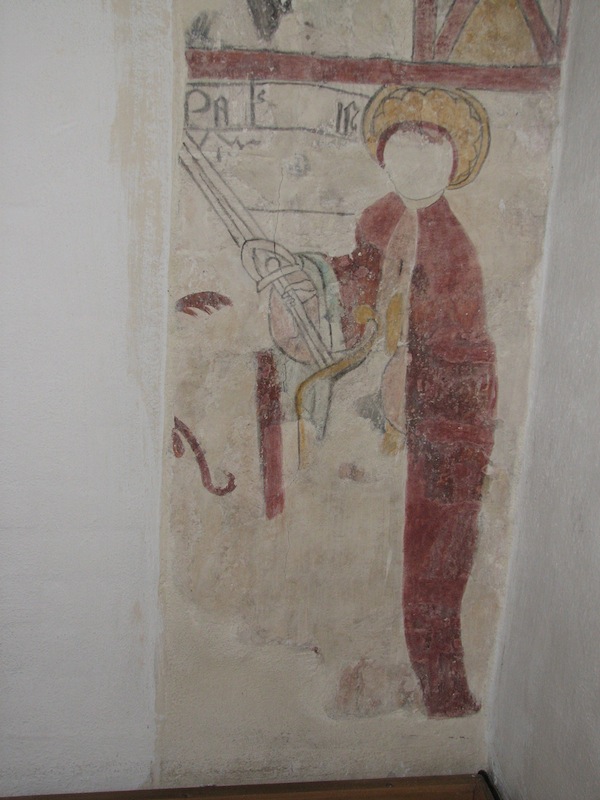
Paulus with two-hander.
Hinge Kirke.
Source: http://natmus.dk/salg-og-ydelser/museumsfaglige-ydelser/kirker-og-kirkegaarde/kalkmalerier-i-danske-kirker/
Last edited by Niels Just Rasmussen on Mon 28 Dec, 2015 4:44 am; edited 3 times in total
|
|
  |
 |
|
Niels Just Rasmussen
|
 Posted: Tue 22 Dec, 2015 5:08 am Post subject: Posted: Tue 22 Dec, 2015 5:08 am Post subject: |
 |
|
You could even formulate a hypothesis that some of the Church-painting-Masters portrayed the swords of the local nobleman in the hands of the biblical figures? Perhaps a good strategic way of pleasing the local powers while you had to work on a church for quite an extended period of time. [Others Masters might have just made "generic" swords].
Look at these Late gothic (1475-1550) church painting from Sennels Kirke in Northern Jutland (Thy district).
Scholars are very conflicted about the dating (1525-1550). Images of the "World Judgement" stops after the reformation (1536), but the scene has an inscription in Danish instead of Latin, which points to after the reformation (1536). So I would say 1530's most likely.
These are from an artist that shows three swords in the church and they are VASTLY different. So absolutely not based on "lets show some generic sword" but very specific.
Also I can't seem to find any "generic" way of portraying sword carried by a biblical figure with a specific type as it varies all over the place.
Sennels Kirke is only 5 km from Sperring Sø where you in the 1800's found two panzerstecher's!
Especially the best preserved panzerstecher with the pommel is quite a good look-a-like to the sword Matthæus is holding!
Then you have Phillip holding a vastly different sword which I haven't seen in any other Danish church painting so far - a shortened sword-staff maybe.
Paulus shows a two-hander with cross-guard and ring and with unusual great blade details showing multi-fullered upper part of the sword (Oakeshoot type XX ? or like the pretzel swords ?)
If we say around 1530's then the local manor around Sennels was "Ullerupgaard" - changing names through medieval times from Woldorp (1394) -> Vollerup (1493) -> Ullerup-gaard (1532) - was owned by "Niels Skeel til Nygaard" who handed it over by enfeoffment (Danish: forlening) to Thomas Thomsen (of the Northern Jutland Sehested family, not the one with the same name from Holsten).
In 1532, 1536 and 1539 Thomas Thomsen writes his name "Thomas Thomsen til Ullerupgaard" showing he is the manor resider precisely in that time period of most likely dating of the Sennels church paintings. We know he is still alive in 1552.
Source: http://www.thistedmuseum.dk/Historisk%20%C3%8...ardene.pdf
So maybe the weapons depicted in the church are his weapons.......
It is very possible that Thomas Thomsen (or Thomesen) is the brother of the first really prominent member of the Jutland Sehested family - Jens Thomesen (died 1555) - who was "Landsdommer" (Chief Justice) in Jutland.
Earliest known members of the family from Vendsyssel are Torben (Thorbern) and Thomas Troelsen (written Thruælss) mentioned in 1337.

Sehested (Vendsyssel origin) Coat of Arms from Torben Troelsen in 1337 (here "modernized").
Source: http://finnholbek.dk/genealogy/showmedia.php?...nkID=16809
 Attachment: 87.18 KB Attachment: 87.18 KB
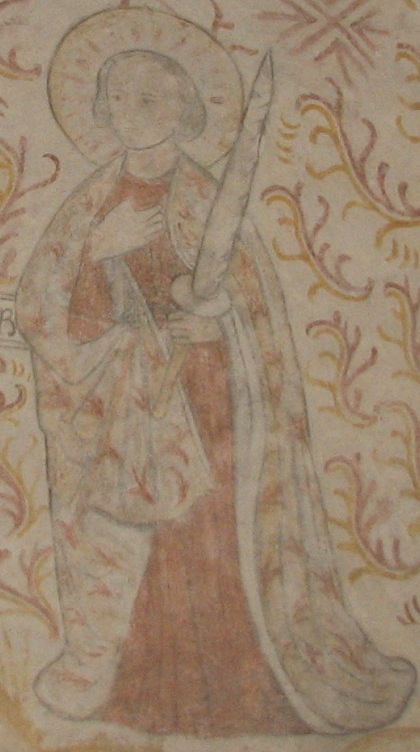
Philip.
Sennels Kirke.
Source: http://natmus.dk/salg-og-ydelser/museumsfaglige-ydelser/kirker-og-kirkegaarde/kalkmalerier-i-danske-kirker/
 Attachment: 83.33 KB Attachment: 83.33 KB
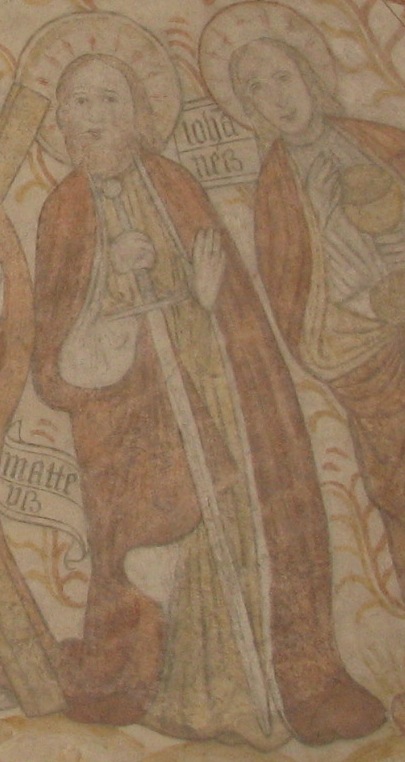
Matthæus with two-hander.
Sennels Kirke.
Source: http://natmus.dk/salg-og-ydelser/museumsfaglige-ydelser/kirker-og-kirkegaarde/kalkmalerier-i-danske-kirker/
 Attachment: 99.07 KB Attachment: 99.07 KB
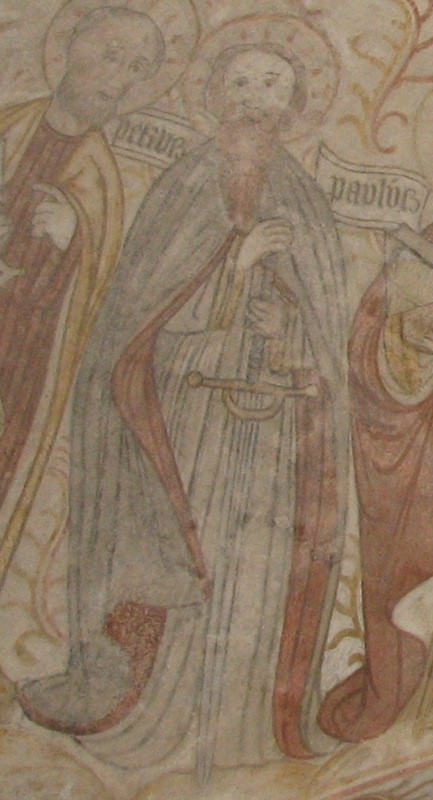
Paulus with two-hander.
Sennels Kirke.
Source: http://natmus.dk/salg-og-ydelser/museumsfaglige-ydelser/kirker-og-kirkegaarde/kalkmalerier-i-danske-kirker/
Last edited by Niels Just Rasmussen on Mon 28 Dec, 2015 4:46 am; edited 2 times in total
|
|
  |
 |
Daniel Wallace

Location: Pennsylvania USA Joined: 07 Aug 2011
Posts: 580
|
 Posted: Tue 22 Dec, 2015 7:27 am Post subject: Posted: Tue 22 Dec, 2015 7:27 am Post subject: |
 |
|
other than the skinny ricasso on these swords, something else that's popping out at me, is the limited quillons.
quillons are usually made in relation to the grip to guard the hand. The further the off hand is back - the longer the quillons need to be to protect the hand. on a lot of these shown in the museum photos and the depictions of art there are limited.
poses a few questions, that gets my head turning.
I did blow up my first pics of D11695 - I did use the sword next to it in the plate from the first post since it's length was known - however the pic is distorted enough that it looks like I'm 5mm too long in the pummel area. original measure was 5.5cm, my print out came out at 6cm. going to work with it a little more see if I can get it a little tighter. although when I full sized the blade, that worked out well for it's with. That came out to 3.8cm-3.9cm again pixilation of such a small image doesn't help, but it did work out to be just a hair broader than the Kalundborg 6605. once I get some basic stats, I can attempt to resize the photo from the museum compare them up and just see what happens. that may give a very rough idea.
|
|
  |
 |
|
|
You cannot post new topics in this forum
You cannot reply to topics in this forum
You cannot edit your posts in this forum
You cannot delete your posts in this forum
You cannot vote in polls in this forum
You cannot attach files in this forum
You can download files in this forum
|
All contents © Copyright 2003-2024 myArmoury.com — All rights reserved
Discussion forums powered by phpBB © The phpBB Group
Switch to the Basic Low-bandwidth Version of the forum
|

